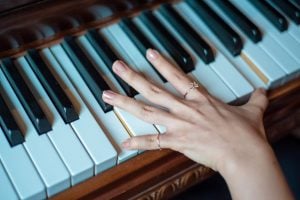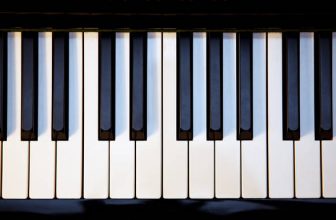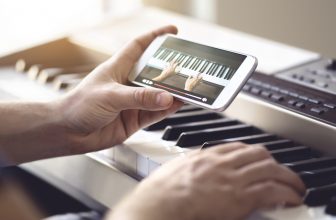
Do you dream of playing music like a virtuoso; of creating sound-magic when you tickle the ivories? Then I have good news for you: You don’t have to finish music school to learn how to play the piano. You can take in the basics from the comfort of your own house! Keep reading to find out how to learn the piano by yourself at home.
How to Learn to Play the Piano by Yourself at Home
Do you daydream about learning how to play the piano? Maybe your local music studio isn’t open due to quarantine, or you don’t have the means for private music lessons. You keep asking yourself the question: How can I learn to play piano by myself?
I’m here to teach the 9 easy steps. First things first, let’s make sure you have a piano.
- Choose Your Instrument Responsibly
We recommend that you buy a new piano in a specialized store. Listen to the advice of a professional consultant who works at the music shop. And be sure to visit a few stores before making a final decision.
Sure, everyone wants a Steinway. But stay within your budget! This next section will help you to decide exactly which kind of piano is right for you. Looking to dabble, but you’ve never touched a piano before? Try getting a 61 key keyboard. A basic keyboard will help get you started. You won’t have to worry about intricate dynamic techniques, because the keys won’t be weighted. And, they’re portable enough to bring with you to a gig.
However, if you already know some basics, or are planning on being a concert virtuoso someday, you should get the keyboard with 88 keys. This will make it easier to switch between the keyboard and the traditional piano. Try getting weighted keys if you have some piano experience, or if you want more control over the volume of sound.
The last option is an acoustic piano. As opposed to the electric pianos we discussed earlier, the acoustic piano has real strings inside. These are often the most sonically pleasing. That being said, they require more space and can be hard to maintain.
- Learn How to Care for Your New Equipment
Don’t forget to tune your piano! If you have a traditional upright piano, you have an acoustic instrument with real strings! This piece of equipment requires adjustment. Acoustic pianos need to be tuned every year. For this, you will need a tuner. It’s best to not attempt to tune it yourself. I have a bachelor’s in music, and still, yet, I wouldn’t dare. If you don’t know where to start, try calling your local music repair shop. They can put you into contact with a professional piano tuner.
To keep an electric piano safe, place a cover like a light sheet over the top of the keys and speakers when it’s not in use. This prevents dust from getting in between the keys or inside the electronics.
Think about why you want to learn how to play the piano. Is it because it’s a family tradition? Or do you want to develop better cross-brain communication and motor skills? Knowing why you want to play can help you to set goals in the future. That being said, if you want to learn how to play the piano just so you can be better at it than your sister, then you might want to reassess your motivation. Internal motivation will always get you the furthest.
To keep yourself going, try the following tips:
- Schedule your practice ahead of time in a planner
- Create a piano notebook where you log your practice time and song goals
- Write inspirational music quotes on a whiteboard
- Print out sheet music that is too hard for you right now, but that you want to work up to. This might be your favorite pop song or Flight of the Bumblebee. Leave it on your music stand as a reminder of your goal.
Remember: Learning piano yourself can be challenging, but it’s very rewarding in the long run.
Before you start playing notes, practice cupping your hands into a ‘C’ shape. Keep your wrists and elbows in line with your hands. Now, hover your hands over the keys. Keep your fingers curved when you play, and be sure to not let them cave in.
Fending off tension is essential in the process of learning any instrument. When you learn piano by yourself, this is especially important. Remembering to keep wrists relaxed and fingers curved will help prevent tension-related injuries such as carpal tunnel. Practicing yoga or The Alexander Technique can also help your body feel more comfortable on stage in the long run.
Take a look at your hands. Curve them into a relaxed C shape as we talked about. Now, we are going to number your fingers so it is easier to learn how to play. The thumb is finger 1. First is finger 2, the middle is finger three, your ring is finger four, and pinkie is finger five. When you’re first learning, you might mix up your thumb and index finger as number 1. But don’t worry, you’ll get used to it! Learning your finger numbers will help you to read music faster later on.
Let’s learn how to make a C chord with your right hand. This position is called root position. Using a piano chart, find middle C. Place your thumb on this note. Remember, this is called finger one. Next, place your middle finger on the third of the scale (E). We will stretch the pinkie to the fifth note of the C scale (G).
Pro Tip: For playing ease, keep your fingernails short. Nails that are too long can cause technique issues, as well as unwanted clacking!
Another essential part of playing the piano is posture. Correct posture will improve technique in the long run. Your head, shoulder, and hips should all be aligned. Keep your feet flat on the floor. If you find that the bench is too tall for you, purchase a footstool.
Here comes the music theory! The next step in learning piano by yourself is to learn the notes and their location. You can play songs by ear, but mastering how to read music is an invaluable tool. The piano uses both bass and treble clefs. Pick one, and start learning it. I recommend learning the treble clef first. After you gasp the treble clef basics, you can play melodies in your right hand! The Bass clef will help you to play accompaniment parts in the left hand.
To help you remember clefs, create your own acronyms for the lines and spaces. Acronyms are great learning tools for reading if you’re just starting out. For treble clef lines, the notes are EGBDF. Some people like to say ‘Every Good Boy Deserves Fudge’ and other phrases to help them remember. Other things that can help you read are beginning theory books or accelerated adult piano courses, such as the Alfred series.
Sometimes it is difficult to understand nuances of the piano just from books. Luckily, the internet can help in your mission to learn piano by yourself!
Scout Out Free Tools
One amazing tool is https://pianomarvel.com/ . You can make a free account. And if you don’t have a piano yet, I have good news for you! You can start by playing on their virtual keyboards. Piano Marvel also has video lessons available, so you can teach yourself from the comfort of your home, with a little guidance from professionals.
IMSLP is one of the best sources for free music. You can find piano method books for beginners, as well as advanced solo pieces such as those by Chopin and Rachmaninoff.
Listen to Music Online
To help you learn, listen to more music! Studies have shown that listening to music actually lights up the ‘practice’ areas of the brain. If you’re trying to learn piano by yourself but don’t have much time to practice, try listening to music on your way to work. Listen with intent, and try and pick out specific notes and rhythms in the piece. Appreciating classical music will help you learn to play.
- Choosing a Pedagogy
You can find source materials and piano pedagogies online. Use the internet to help you decide which method is best for you. Some music pedagogies that are popular include the Suzuki method and Orff. To help you learn piano by yourself, you can choose one of these methods. This will help you stay on track and inside an organized plan.
- Just Keep Practicing!
You’ve probably heard this before, but consistency is key. This is especially true when you are planning to learn by yourself; there will be no teacher to tell you to keep practicing! If you’re serious about the piano, be sure to engage every day. Even just 15 minutes of daily training will significantly improve your musical skills.
If your goal is to master the basics of playing the piano quickly, don’t neglect your practice time. Remember to set aside a specific time every day that is intended just for practice. Write in it your planner, and when the time comes, turn off your cell phone!
Efficient Practice
Before we wrap up, keep in mind that all practice is not good practice. To practice efficiently, use a method called ‘chunking’. Chunking means taking something that is difficult and cutting it into small, bite-size pieces. Practice things that are hard in small pieces before putting them into the context of a whole song. While it might not sound like any fun, practicing with chunking will make you a better piano player, fast.
- Train Your Ears
The last stage is this: work on your aural skills. This is similar to the concept that we touched on earlier. Some people have more developed ears than others. But don’t give up! Listening is a skill that can be honed. Take me for example. My ears are better at recognizing chords and notes in the scale than they are rhythmic patterns. However, after many hours of practice, I improved my rhythmic recognition skills. With a little time and effort, anyone can train their ears!
There are many great apps for ear training, such as Functional Ear Trainer. Do some research, and find an ear training style that suits you. Apps like Functionals Ear Trainer help you to recognize arpeggios and specific notes, like the third of the scale. Once you improve your ear, you’ll improve your piano playing too! All of this can eventually be used for creating your own compositions, or for improvizing with a friend. So keep at it!
How to Learn Piano by Yourself: Final Tips
Here are some final tips to keep you centered without a formal teacher:
- Don’t rush
- Stay patient
- Don’t do things halfway
If you haven’t mastered the notes, don’t try to play it fast. This is one of the biggest mistakes I see in beginners, both young and old. Rushing your songs will only hurt you in the long run. Playing too fast too soon can create tension in the wrists, fingers, and body as a whole. This will actually slow you down. Your pace and technical skills will come with time. When you practice, fully commit. If you don’t work on transitions slowly, and never turn on the metronome, you’re only practicing halfway.
As with any training, there are ups and downs. Don’t give up after your first bad practice session. I’ve had bad practice days, weeks, and even months! But know that consistent effort will bring you success!
Remember, these are the 9 steps that will help you to learn piano by yourself:
- Choose an instrument
- Learn how to care for it
- Learn proper posture and technique
- Teach yourself to read music notation
- Use the internet to source materials
- Choose a pedagogy
- Be persistent in your practice
- Train your ears
If you follow these tips, you will be playing your favorite songs in no time. Happy practicing!






